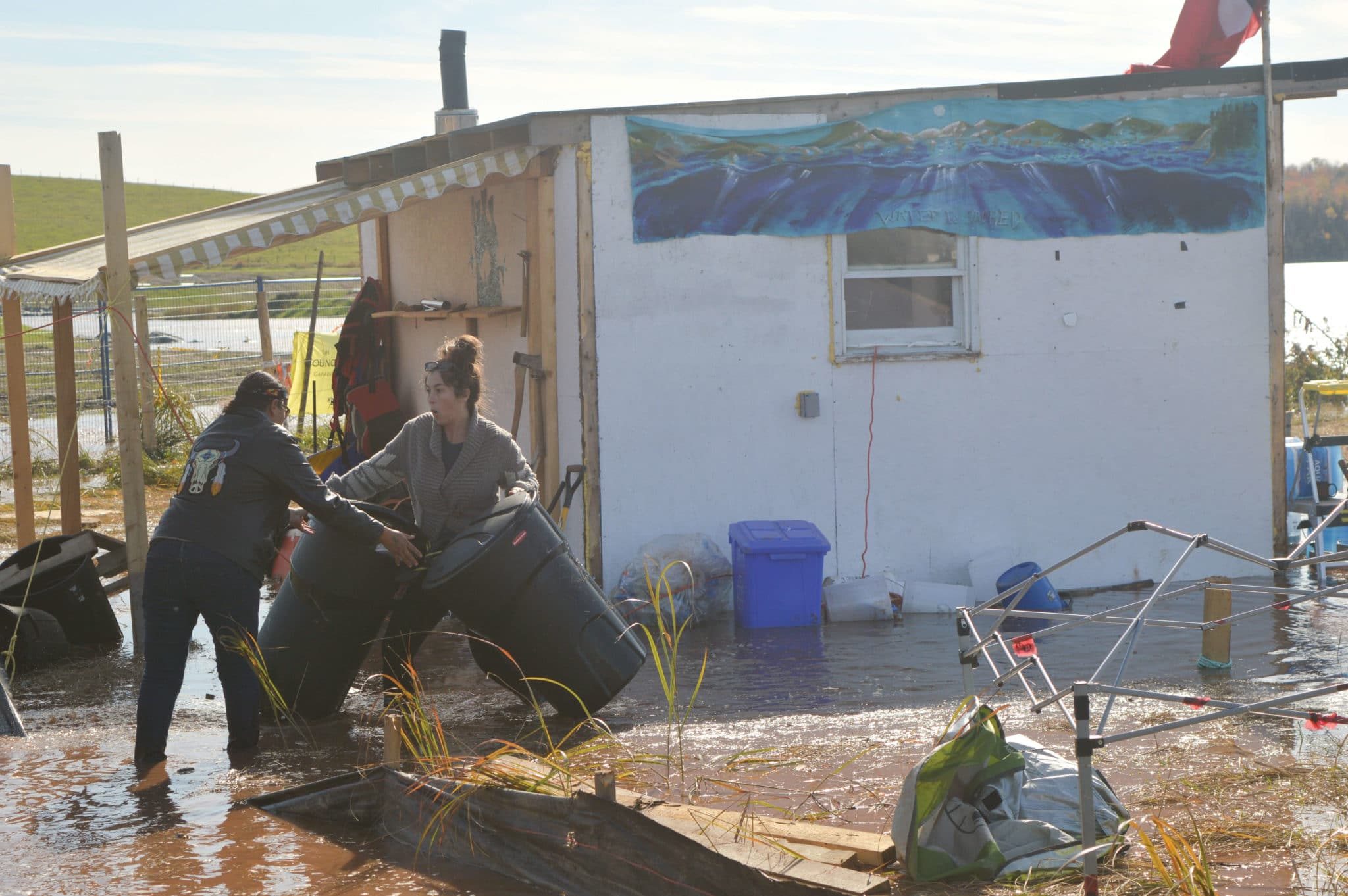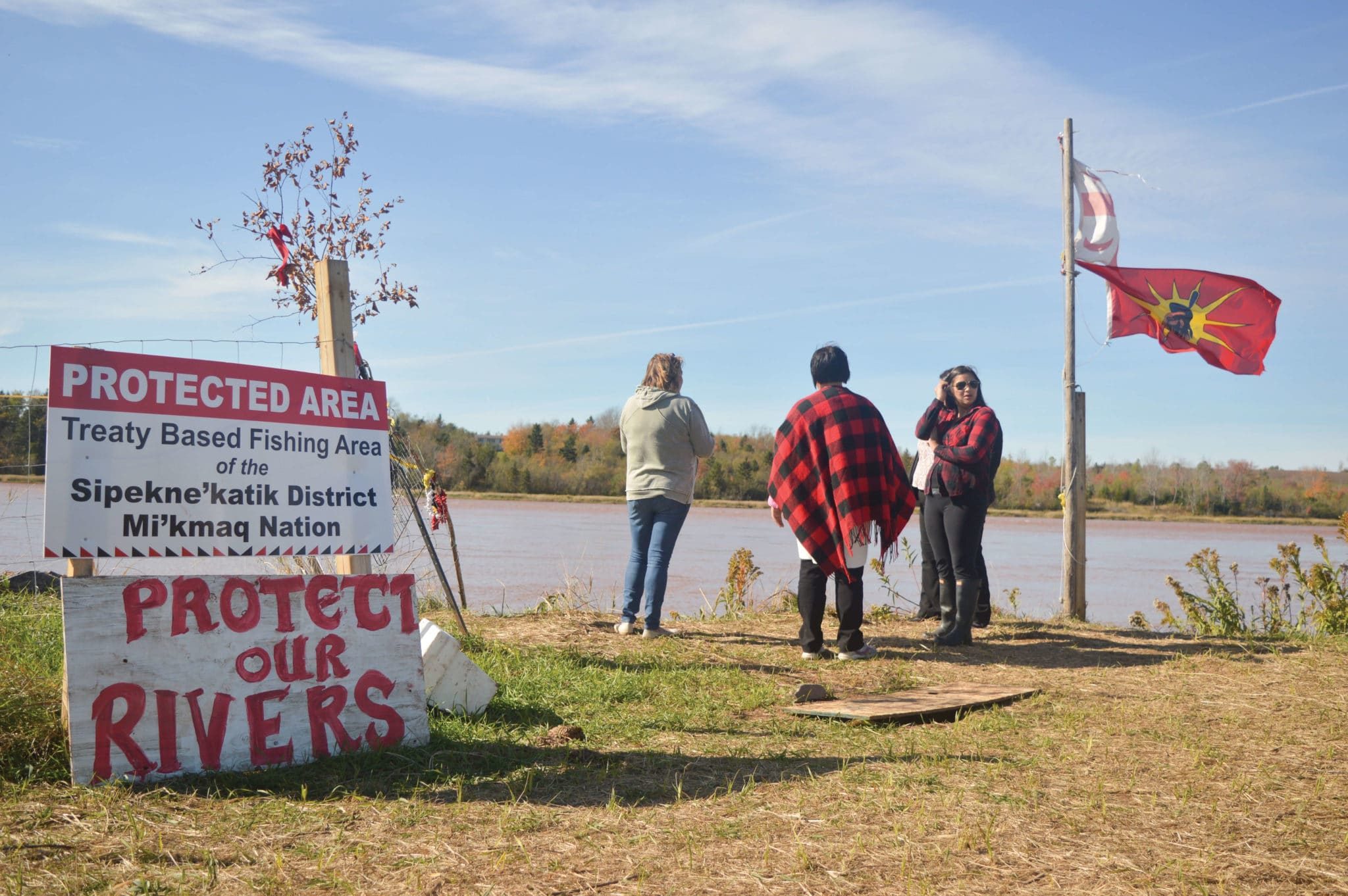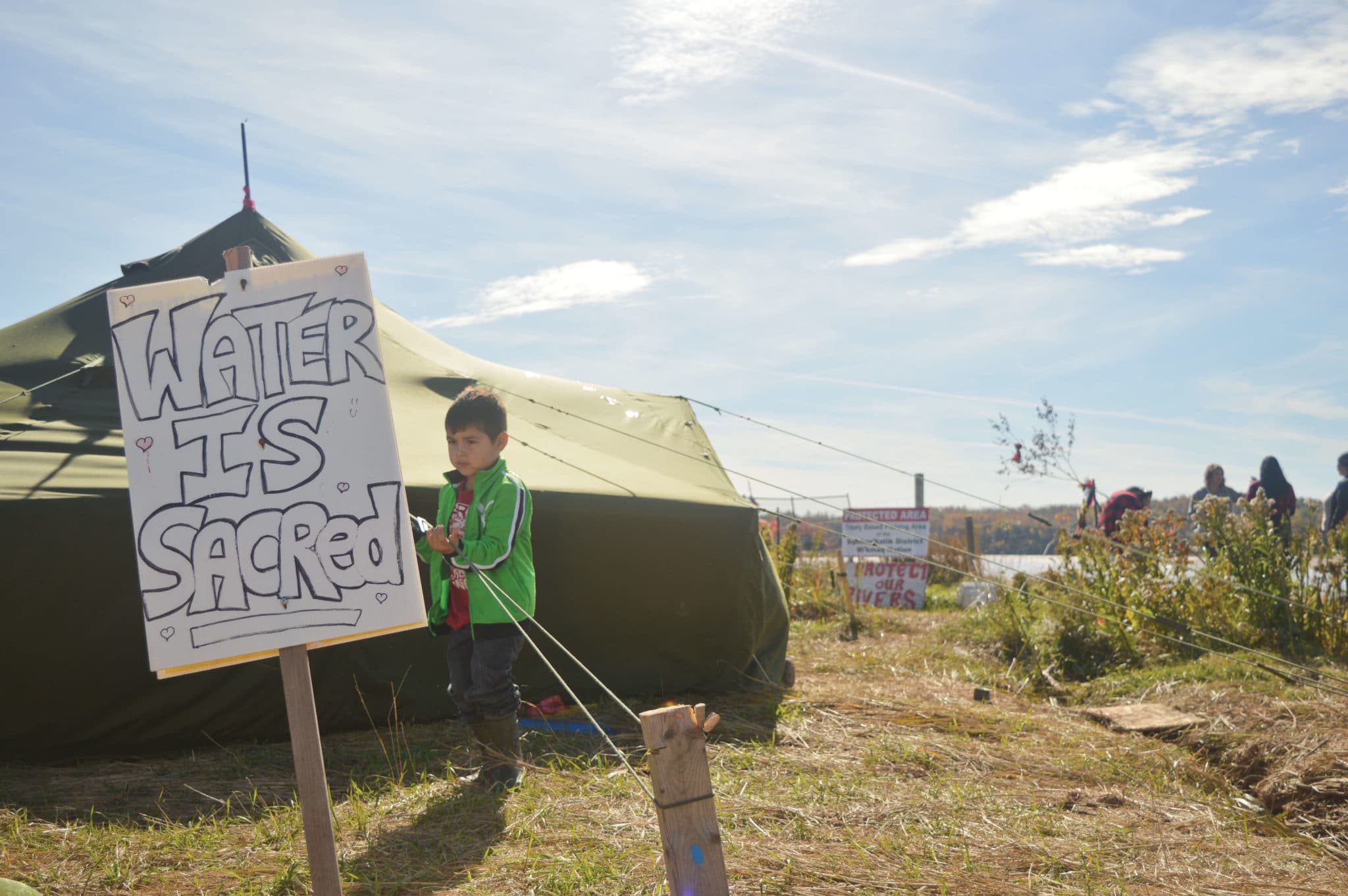“Grab the cake!” someone shouted, as the water protectors rushed to higher ground. The river was rising.
We arrived at the truck house, the site of the activists’ resistance, just as the tide began to rise on the banks of the Shubenacadie River, an estuary of the Bay of Fundy. On Sunday, Oct. 16, we spoke to Mi’kmaq and non-Indigenous water protectors who have been there for over two months blocking the construction of an Alton Gas natural gas storage facility.

Annie Clair, a mother and grandmother from Elsipogtog First Nation, has been active at the truck house since early October. Clair has spent a handful of nights at the encampment and opposes the Alton Gas project because it threatens the river and the wellbeing of future generations.
“The reason why it’s so important is because the earth needs water, trees need water, and if they’re going to start doing all this stuff it’s going to poison everything,” Clair said. “It’s not just a Native issue, it’s everybody’s issue. We all have to stand together.”
The Project
Alton Gas Natural Storage, a subsidiary of the Alberta-based AltaGas, is attempting to construct an underground storage facility that would hold 100 to 170 million cubic metres of compressed natural gas. The facility is being developed on the bank of the Shubenacadie River near Alton, N.S.
The project’s completion requires flushing out the salt caverns beneath the banks of the river. Alton Gas has proposed to divert the resulting salt water, known as brine, into a holding pond before releasing it into the Shubenacadie. The proposed caverns will be up to 1,000 metres deep.
Many Indigenous people in the area claim they were not informed of the provincial and company consultation periods. Public input on the project was accepted by the provincial government from Nov. 23 to Dec. 6, 2007. Less than two weeks later, the project was approved by the Nova Scotia Minister of Environment.
In September of 2014, the Assembly of Nova Scotia Mi’kmaq Chiefs issued a press release opposing further construction of Alton Gas’ $100-million facility.
Despite living within a few kilometres of the construction site, Cheryl Maloney, a member of the Sipekne’katik First Nation, had not heard about the project until reading the press release.
“That was the first time I ever heard about the project. That was the very first time a lot of people heard about the project,” said Maloney, a spokesperson for the truck house activists and president of the Nova Scotia Native Women’s Association.
A group of water protectors, including Maloney, demonstrated for two months in 2014 and spent Treaty Day, Oct. 1, of that year raising awareness about the project beside the highway. The Sipekne’katik Band appealed for an injunction this year to challenge Alton Gas’ claim that it had undertaken adequate consultation with the band. In August, when a judge postponed the hearing until November – two months after Alton Gas was scheduled to begin brining – they decided to act.
“So once we knew that it was pretty much a loss, we just said, ‘You know what? We’re going to come over. We’re going to set up our truck house here,’” Maloney said. “We wanted to bring the media and the community together at the truck house to see the actual river that we are trying to protect.”
In August, water protectors gathered on the bank of the Shubenacadie to build a truck house – a structure protected by the Treaty of Peace and Friendship 1760 and used by the Mi’kmaq people to trade and fish.
From the road, the encampment is hidden by a dyke that runs along the river. As we approached the dyke, we passed a Mohawk warrior flag flying in a meadow. Children ran around the truck house below as we walked along the dyke. A blue fence, which the company erected after the water protectors arrived, stood between the construction site and the encampment. One woman had brought a cake with brown icing that read, “Celebrating the Shubie River.” Each time we looked back at the water, the tide was higher than before.
In the early days of the resistance, dozens of people came to help and express solidarity.
“Even before we knew we needed something, it would just show up,” Maloney said. “People brought boats, canoes, tents, woodstoves – things we didn’t ask for or even know to ask for.”
Kevin Tiley, a carpenter from Halifax, took three weeks off work to help construct the truck house in late August. Tiley said the site has become a rallying point for a community of people who are concerned about the local ecology.
“This is along the sames lines with any community that is being pushed around by big corporations and big business,” he said. “They’re basically having their rights stomped on.”

As we arrived at the encampment, we watched one of their boats, which had unmoored in the storm the night before and floated up-river, return with the tide. Many of the protectors joked that this was a good analogy for how difficult it would be to flush brine out of the river.
Mother Bear, from Unama’ki First Nation, has been spending nights at the truck house since Sept. 4. Two to four water protectors guard the camp every night, while security guards hired by Alton Gas sleep on the other side of the fence. Mother Bear said spending the night on the river is an immersive experience.
“It’s warm and comfortable, it’s calm, your mind doesn’t think about anything else,” Mother Bear said. “It just goes with the river, then it comes back.”
The truck house has provided a sense of purpose to many involved in the resistance. Karlyn O’Hanley, who commutes from Cole Harbour to spend time at the encampment, said the action has given her a sense of direction and belonging.
“We’re not here for power, or money, or prestige. It’s cold at night, it’s wet, but it’s life and it’s the earth and it needs to be supported,” O’Hanley said. 
While Alton Gas owns the property, the construction site and the truck house are on unceded Mi’kmaq land. Because of this, Maloney questioned the legality of Alton Gas’ activity.
“We have aboriginal title over this land. We don’t need to go to court to prove it. This is Mi’kmaq territory, most importantly. And anybody here is here based on the strength of their relationship with the Mi’kmaq,” Maloney said. “Right now, Alton is trespassing on unceded territory.”
The Resistance
Water protectors claim the proposed release of brine into the river would threaten the Shubenacadie ecosystem.
Mother Bear, an inshore fisher, said the brining threatens her constitutional right to fish in the river. She is concerned that the project will damage the fish habitat and adversely affect the migrating geese and ducks

that fly through the region.
“Water is precious,” Mother Bear said. “Water is our life.”
As a declaration of their treaty rights, protectors have set eel traps along the mixing channel dug by Alton Gas. By removing the traps, Alton Gas would be infringing on the Mi’kmaq people’s right to fish. Within weeks, the traps were buried as the channel filled up with mud.
“The river is already healing itself,” Clair said.
As we spoke to protectors, a small stream of water began to trickle through the grass – the tide was rising above the river bank. One man told us to start moving equipment to higher ground. As the river continued to rise, people started scrambling, picking up food and supplies and carrying it to the top of the dyke. Within minutes, the entire camp was under nearly a foot of water.
“Alton [Gas] science that says, ‘We can mix in this and send it out to sea,’ is being challenged by Mother Nature herself,” Maloney said while overlooking the flooded camp from the dyke. “They don’t know this river. Their scientists are just academics. They do not know what we know.”
Maloney said that it would be naive to think that Alton Gas’ interest in the area is limited to storing natural gas that has been hydraulically fractured elsewhere.
“Nova Scotians need to wake up. This is fracking infrastructure. We’re going to have pipelines coming offshore in and out of the U.S.,” Maloney said. She added that this infrastructure could encourage future provincial governments to lift the moratorium on fracking.
The purpose of the truck house is to block the construction of the storage caverns. Harriet Annabelle Thiebaux, a 75-year-old woman from East Hants, N.S. who is new to activism, blocked the driveway to the Alton Gas property for two weeks – making it impossible for trucks to enter the construction site.
“I disapprove of this company,” Thiebaux said. “I disapprove of the whole industry.”
The River
We approached Yanic Breton, an 11-year-old Mi’kmaq water protector, while he was trying to keep his new puppy Mukwa out of the mud. Breton likes to spend his weekends and holidays at the truck house. We asked him why he was there.
“To prevent them from fracking and from putting all the bad stuff like – I forget what it’s called.” After asking if he meant brine, he said, “Yeah, something like that, and they’re going to put that in [the river]. Well we’re trying to stop them and we’re going to win the battle.”

A week after we visited the camp, Alton Gas announced that it would postpone its construction of the storage cavern until 2017. Many at the truck house attributed this decision not only to their resistance, but to the river itself. Maloney said that the buildup of mud in the mixing channel made it difficult for the company to continue construction.
“Honestly, I knew they weren’t going to be able to work. We were just waiting for them to admit [it],” Maloney said on Monday over the phone.
Many of the water protectors interviewed felt that their actions were in line with the ongoing mobilization of Indigenous communities across Turtle Island (North America). From Muskrat Falls, N.L., to Standing Rock, N.D., Indigenous land defenders and water protectors are resisting industrial exploitation.
“The people are coming and the people are waking up,” Clair said. “We don’t have much time left, so it’s happening everywhere. There’s a reason.”
As we left the camp, the water had already begun to subside. Water protectors shared the rescued cake and homemade meals. Spirits were high, and no one seemed phased by the flooding. They did not return their supplies to the camp, as they knew the tide would breach the bank again that night.
“It’s amazing because the tide’s up high now – it’s a hunter’s moon,” Mother Bear said. “The channel, it’s so powerful.”






